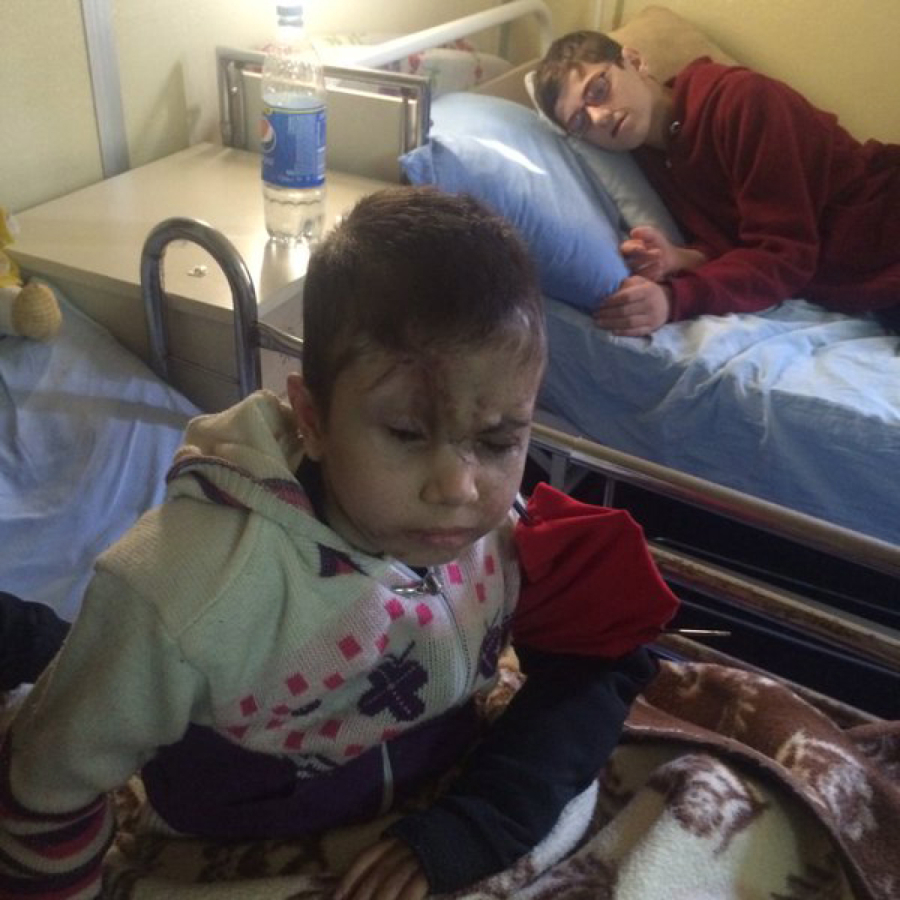In most countries, 6-year-old Shaima would be in school, frowning through worksheets before scrambling to the playground at recess.
“She used to zoom home and do her homework so quickly, I would suspect she was lying, but she really would finish it in no time,” said her father, Mahmoud Tafeye.
But without significant luck, the child may never see again, blinded by a sniper’s bullet that ripped through her family’s minibus and sliced through her head and arm last November.
Shaima’s childhood, like those of millions of other young Syrians, was shattered by a war that has spurred the gravest displacement crisis since World War II. Of the country’s 4.3 million refugees, at least half are children.
Exactly one year ago, the war’s toll on children was painfully underscored by the image of a little boy lying facedown on a Turkish beach. In death, Alan Kurdi became a symbol of Syria’s “lost generation.”
Shaima’s own escape was a narrow one. She had lived her first five years in the east Aleppo suburb of Sukkari, before the November morning her parents packed their two children into the minibus in a panic as fighting neared. When bullets started to fly – apparently from Kurdish forces – she was hit and blinded in both eyes. Her 12-year-old brother, Abdo, whom Mahmoud described as Shaima’s “protector,” was killed.
Children are thought to account for about 20 percent of the almost half-million Syrians who have died during the course of the five-year conflict. According to UNICEF, an additional 8.4 million children – more than 80 percent of the country’s youth population – have been affected in some way, either living with violence in Syria or fleeing abroad.
Across rebel-held parts of the country, repeated strikes on hospitals have severely limited access to health care. As soon as a Syrian becomes a refugee, a host of new problems begin, including the need for new paperwork to access a foreign country’s health-care system as well as the need to endure extensive waiting lists.
After arriving in southern Turkey, Shaima would lie for months in hospitals and clinics, at times curled up so small under a blanket in Mahmoud’s arms that an observer might have missed her.
What happened next confounded everyone. “She fought and she fought,” her father said. “And she survived.”
By her sixth birthday, she could stand tall again. In a photograph from that day, she is wearing a party hat and a quizzical expression, lost in thought as she clutches a balloon.
“We thought she was going to be paralyzed, but she is a fighter,” Mahmoud said in a phone interview from Turkey this week. “She keeps telling me: ‘Baba, it’s OK that the sniper hit me – I am not sad. God meant it to be this way, and I know I will get better.'”
With the help of specialized medical care abroad, doctors believe, Shaima will see again.
The invisible wounds of war are harder to treat. Aid groups say most Syrian children they encounter show signs of trauma, including severe anxiety, flashbacks and even suicide attempts. Although international and local organizations offer an array of counseling services, they reach only a minority of refugees in Lebanon, Turkey or Jordan, the countries where most Syrians have settled.
Lina Sergie Attar, co-founder of the Karam Foundation, which provides support for Syrian refugees, said the levels of need shocked even experienced trauma professionals.
“It’s not just the children, it’s everyone. It’s parents, it’s teachers,” she said. “Many of these people have traditionally relied on their families, on their neighbors, for support. With the war came a total unraveling of that.”
Marking the anniversary of Alan Kurdi’s death this week, Amnesty International Secretary General Salil Shetty called on wealthier countries to do more to assist Syrian children.
“Until wealthy countries take more responsibility for the crisis unfolding before them, and take in a fairer share of the people fleeing war and persecution, they will be condemning thousands more children to risk their lives in desperate journeys or being trapped in refugee camps with no hope for the future.”
Photographs of the child were shared millions of times, prompting fierce debate over global responsibility for Syria’s refugee crisis. But in the year that followed, a powerful wave of right-wing populism across Europe and the United States, as well as repeated Islamic State-linked attacks across both continents, appear to have reversed what small concessions the little boy’s death inspired.
“Politicians said after the death of my family: never again,” Abdullah Kurdi told Germany’s Bild newspaper this week. “Everyone allegedly wanted to do something after the photos that had so moved them. But what is happening now? The dying goes on and nobody’s doing anything.”
The United States admitted its 10,000th Syrian refugee this week in a resettlement program announced by President Obama last fall, reaching a target set under pressure from European and other countries struggling to cope with the crisis. But the United States, like Britain, has been criticized for focusing most of its humanitarian aid on improving services for refugees who remain in the Middle East instead of sharing a burden by accepting more refugees.
In Turkey, the school system is struggling to accommodate 330,000 Syrian children. About 500,000 have no access to education at all, a fate that increases their risk of exploitation through early marriage or child labor.
Until he raises enough money for Shaima’s eye operation, Mahmoud said, he is teaching her what he can at home. And then, reaching for the phone, the young girl chimed in, her voice strong and mirthful. “I just want to go back to school,” she said. “I know I will be there soon.”



